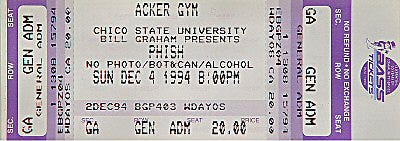
It’s December 4th, and Phish is tired. They’ve played 40 shows in the last two months and five in the last five nights, with another five-night run on the horizon. I’m gassed just writing five essays in five days, never mind playing 2-½ hour shows and bussing around every night. So no surprise that this date is the lowest-rated show on phish.net since way back in Erie, Pennsylvania on November 13th, a further dip after last night ended a three-week hot streak of shows rated 4 or higher.
You can certainly hear it. It’s a very standard setlist — almost ‘93 vintage — with no gaudy track lengths, segues, or teases. There are some uncharacteristic tech difficulties, including two loud squelches of feedback in Possum that will rudely startle anyone listening on headphones, and both sets are on the short side, despite being back to usual no-opener procedure. The general sluggishness is compounded by a pretty rough AUD done no favors by the acoustics of a literal gymnasium, with big drum echoes dominating the other instruments. Four days after I wrote about how they hit the West Coast running so confident they could do no wrong, they’re straining, playing to a couple thousand college kids on bleachers on a Sunday night in North Central California.
The suboptimal conditions expose a flaw in the otherwise pristine condition of Phish in late 1994. They’ve become exceptionally good at what they do, but what they do is basically one thing: provide a high-energy, eclectic night of music with gradually expanding zones of open improvisation. But when that energy is low — and to their credit, it rarely is — they don’t really have another card to play. The “we’re tired” backup plan is the same general mix of material but played less sharply, with only brief, begrudging jams.
Hence the Tweezer on this night, which despite showing up in the first set for the first time since July, is aggressively punching its way towards another Fall 94-style odyssey before it abruptly falls off a cliff around the 9-minute mark. No return to the riff, no slow-down ending, just an angry chord from Trey, cymbal and piano clatter, more unidentifiable tech glitches, and silence, broken calmly by the Fee drums. It’s less a ripcord than a self-destruct button, and it leaves such a bad taste in their mouth, they don’t even Tweeprise at the end of the show.
The second set offers a surprising little glimpse of how Phish might handle such drowsy occasions in the future. At the end of Axilla II, as they’re winding down the slow “don’t shine that thing in my face, man” ending from Hoist, they find themselves in a spacey interstitial zone that glides for a couple minutes before Trey counts off YEM. In a few years, they would be much more comfortable sitting in that textured, minimal space for longer, perhaps by pouring it into an extended 2001 or Siket Disc cut. But in 1994 their crowd-pleasing instinct tells them to play their hardest and longest song, not to mention the one that involves calisthenics.

A lot of developments still need to take place before Phish can follow their mood and construct shows with different personalities. It’s part of why doing an exhaustive show-by-show listen of old tours can be a chore — even if the setlist itself varies from night to night, the overall feel tends to be pretty uniform. The next couple batches of new songs will help, as will the expanding sonic palette brought by new gear and effects. But Phish will also need to learn to be a little more selfish, letting their feelings guide the flow of a concert instead of trying to live up to the role of Party Band each and every night.


